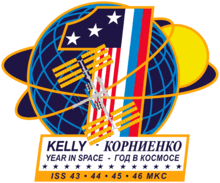ISS year long mission

The Year Long Mission on the International Space Station is a scientific research project that studies the health effects of long term spaceflight.[1] Scott Kelly and Mikhail Korniyenko will spend 342 days in space, with scientists performing medical experiments. Scott Kelly is an identical twin with his brother Mark. Kelly and Kornienko departed in March 2015 on Soyuz TMA-16M along with Gennady Padalka.[2][3][4][5]
The pair will land in Kazakhstan in spring 2016.[6]

In November 2012, NASA, the Russian Federal Space Agency (Roscosmos), and their international partners have selected two veteran spacefarers for a one-year mission aboard the International Space Station in 2015. The mission includes collecting scientific data important to future human exploration of our solar system. Kelly and Korniyenko already have a connection; Kelly was a backup crew member for the station's Expedition 23/24 crews, where Korniyenko served as a flight engineer.

The goal of their yearlong expedition aboard the orbiting laboratory is to understand better how the human body reacts and adapts to the harsh environment of space.[8] Data from the 12-month expedition will help inform current assessments of crew performance and health and will determine better and validate countermeasures to reduce the risks associated with future exploration as NASA plans for missions around the moon, an asteroid and ultimately Mars.[9]
Health studies
The international space station has developed exercise equipment, including treadmills and resistance devices to limit muscle atrophy in a low gravity environment. Weightlessness causes body fluids in astronauts to accumulate in the upper half of the body, leading to facial edema and unwelcome side effects. Studies on astronauts have suggested that weightlessness leads to vision problems due to increased intracranial pressure changing the shape of the eyeball.
Psychological studies
The study will also require the astronauts to keep a journal, and will study the psychological effects of living in a confined space for an extended length of time. Kornienko said of his experiences on Expedition 23/24 "The thing you miss there most of all is the Earth itself, I missed smells. I missed trees, I even dreamt of them. I even hallucinated. I thought I smelled a real fire and something being barbecued on it! I ended up putting pictures of trees on the walls to cheer up. You do miss the Earth there".[10]
Scott stated that he missed feeling changes in the weather while on the ISS.[11]
History
Vladimir Titov and Musa Manarov spent 365 days in space from December 1987 to December 1988.
Sergei Avdeyev spent 379 days on Mir in 1999 and Valeri Polyakov spent 437 days on Mir in 1995.[12][13] The longest mission on the ISS was 215 days, by Mikhail Tyurin and Michael López-Alegría. Sunita Williams holds the record for the longest single spaceflight by a woman at 195 days[14][15]
See also
| Wikimedia Commons has media related to Soyuz TMA-16M. |
References
- ↑ Jeffrey Kluger (18 Dec 2014). "NASA's One-Year Mission with Mark and Scott Kelly". Time (magazine).
- ↑ "Historic yearlong mission crew launches to space station on Soyuz TMA-16M".
- ↑ "Soyuz spacecraft with Russian, US astronauts blasts off for year-long mission". ABC News.
- ↑ "Soyuz rocket launches yearlong space station crew". United Press International. 27 March 2015.
- ↑ "U.S., Russian crew blasts off for year-long stay on space station". Reuters. 27 March 2015.
- ↑ http://www.space.com/28321-obama-state-of-the-union-nasa-astronaut.html
- ↑ "Year-long mission the next step for Kelly, NASA". Houston Chronicle. 20 March 2015.
- ↑ "One-Year ISS Mission Preview: 28 Experiments, 4 Expeditions and 2 Crew Members". The Planetary Society. 25 March 2015.
- ↑ "NASA, Roscosmos Assign Veteran Crew to Yearlong Space Station Mission". NASA. November 26, 2012. Retrieved 2012-11-26.
- ↑ Russian Federal Space Agency (2010-09-28). "Soyuz TMA-18 Cosmonauts Share Some Experiences from Space". Retrieved 2010-10-17.
- ↑ "Crew of First Yearlong Expedition Aboard ISS Previews Mission". NASA/Youtube.
- ↑ Schwirtz, Michael (2009-03-30). "Staying Put on Earth, Taking a Step to Mars". The New York Times. Retrieved 2009-04-15.
- ↑ "Last Human to Spend a Year in Space Discusses Upcoming ISS One Year Mission". Youtube/ReelNASA.
- ↑ Tariq Malik (2007). "Orbital Champ: ISS Astronaut Sets New U.S. Spacewalk Record". Space.com.
- ↑ "Astronaut Bio: Sunita Williams (5/2008)". NASA Logo National Aeronautics and Space Administration. Retrieved 2009-05-07.
| ||||||||||||||||